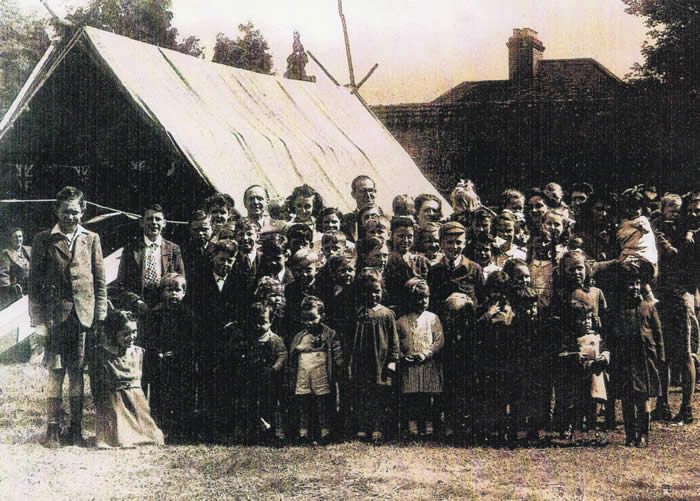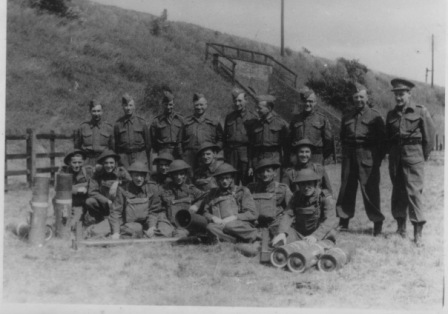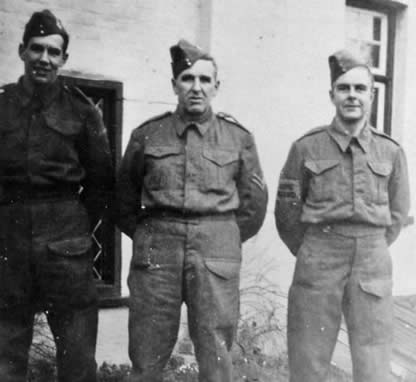
The Home Front
World War Two had an impact on everyone, not just those who were abroad in the services. In this part of the collection, we show how the war affected those on the Home Front, who were fighting the war in their own way, including experiences from day-to-day life and those who served in the Home Guard. The full collection of our findings so far is at Display all WWII Home Front resources.
Longer summaries of stories on this page are available here.
(Interview by Rory Tinker and Lynda Abbott, January 2012)

A 'VJ' (Victory over Japan) party in August 1945 in Lockers Garden. It was held by the residents of Bury Hill and Cemmaes Court Road. Lionel Howard is standing on the far left.
Lionel Howard grew up in Hemel Hempstead during the war. He has vivid memories of the war's impact on daily life.
I think the first thing I remember about the beginning of the war was the gas masks. They were in a little cardboard box with a string that went round your neck. When we were at school they were forever having practices. You had to hook them under your chin and then stretch them over your head. A great game, being boys, was if you breathed in deeply and breathed out quickly the air used to go out of the sides and made a weird noise.
Read more from Lionel Howard here and here.
Yvonne Butler and Gwyneth Tomlin's story
(Interview by Nick Tate, Freya Martin and John Ross, November 2011).
In a wide-ranging conversation about Hemel Hempstead life during the war, Yvonne Butler (then Chilman) and Gwyneth Tomlin (then Daniels), who both attended Hemel Hempstead Grammar School, told us about school, sweets and air raids.
Gwyneth - If the Germans were coming back from somewhere like Coventry and places like that, they would “ stick bomb” down the valley because at that time, this valley had the main canal, the main road – the A41 – and the railway lines all coming through and they would try to disrupt munitions and things coming from Birmingham through to the docks.
Yvonne - Sweets were rationed and we had the equivalent of one crunchy bar a week. I used to save mine up. The local shop would save me four crunchy bars at the end of the month and that was my sweets for the month.
Read more from Yvonne and Gwyneth here and here.
John Stanbridge's story
(Interview by Lynda Abbott and Fay Breed, December 2011)
John Stanbridge attended Hemel Hempstead Grammar School as part of its second intake. His experience at school can be read about here. Later, he farmed St Agnell’s farm in partnership with his father, as SG Stanbridge and Son, and during the war was a member of the Home Guard, as described below.
John told us about his memories of German prisoners of war on the farm:
They were absolutely superb. Of course, they’d all been screened so there were no Nazis amongst them and they all came from farming backgrounds. I remember one winter – I was in charge of a hedging gang. They were used to obeying orders; whatever you told them to do they did it and they didn’t try to keep the job going on to avoid new tasks.
Even on a farm, rationing made an impact:
Rationing affected us. If you hadn’t got potatoes and swedes in winter you would have been in trouble. Until myxomatosis, which was after the war, we killed quite a few rabbits. Rabbit was the main meat during the war. Nearly all our hay production in the war went to London to feed rabbits. Fruit was impossible which I found particularly painful.
Read more about John's farm life here, here and here.
Peter Mullard's story
(interviewed by Sophie Horwood)
Peter Mullard was seven years old the month war broke out, September 1939. He was just about to start George Street Junior School, and lived in Herbert Street in Hemel Hempstead. In 1943 he later moved on to the secondary school in Crabtree Lane. Peter Mullard tells what it was like to be at school during an air raid. He describes how the shelters were partly underground and says:
It was dark down there, but we were not really scared because we were all in it together. I seem to recall that there was some form of artificial lighting, probably paraffin lamps. We sat on benches facing each other. There was no heating. We spent many hours in the shelters, particularly when the V1 (Doodlebug) attacks started followed by the V2 rockets. I believe I am right in saying that we did some of our end of year exams in 1944 sitting in the shelters.
Read more about Peter Mullard's experiences, including his descriptions of Hemel in 1939-45 here and here.
The Home Guard

Boxmoor Home Guard
Many of the members of the Home Guard were veterans of World War One. A Hemel resident who fell into this category was Edward Grayson who served in the Boxmoor Home Guard. Originally from Lurgan in County Armagh, he served in the Royal Flying Corps and Royal Air Force in WWI. He moved to Hemel in 1939 with his wife and children. You can read more about him here and see a picture of the Boxmoor unit here. You can also see a certificate awarded to Frederick Baxter here.
John Stanbridge (interviewed by Lynda Abbott and Fay Breed in December 2011) was another member of the Home Guard. He remembers:
We were called the Local Defence Force and Churchill re-named it the Home Guard. A very clever move that was and not only that, they took it further. They made us a section of the British Army and our officers were given full commissions. We were allowed to wear the Herts badge on our caps and that’s when morale went up tremendously.
John Stanbridge (left) with other members of the Home Guard
Read more about the Home Guard here and John Stanbridge's Home Guard experiences here.
Display all WWII Home Front resources
